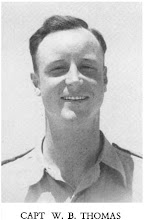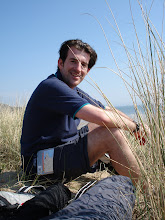A bit of an early start. We were up and about by 0700, as there were a few things left to organise. First stop was the Pilgrims Office, where we needed to pick up our diamonitiron (the paper pass we require to enter on to Athos). The previous evening, we had been told by a shopkeeper that it would not be a problem to cross the road border and enter on foot - it was simply a case of convincing the Greek policeman manning the border that we were bona fide.
The man in the pilgrims office wasn't nearly so positive. He confirmed that entry on foot was forbidden by the 1922 law. There was no-one we could call, and he got pretty heated about the whole thing. We decided not to risk being flung off the mountain and instead organised a ferry to the first landing point. This was a frustrating start to the day. It seems that Sandy also broke the law in 1941, and the man in the pilgrims office said that he could have been prosecuted. I suspect that would have been the least of his worries!
Anyway, 68 years of progress has thrown up plenty of bureaucratic obstacles. With heavy hearts we conceded defeat, and trotted down to buy a ferry ticket.
The town was already awake, with much chatter as the shopkeepers set out their stalls - anything and everything connected with Athos is on sale; icons (large and small), posters, maps, porcelain model monasteries, monastery themed clocks, hats, scarves, flags and even walking sticks! No copies of 'Dare to be Free' which is pretty poor - they even had Athos cookbooks!
We avoided the worst of the excesses, and headed down to the tower for breakfast. Tyson and I found the local bakery and filled our packs with all sorts of goodies. The others went for an omlette soaked in olive oil. Each to their own!
The ferry arrived by 0900, and we watched as vans and lorries arranged themselves on the deck. All around us swarthy looking men were having a final coffee and cigarette before heading on to the boat. We joined the queue on the pier, all clutching our tickets in the pouring rain.
When we finally left Pyrgos, the boat was packed. Every available chair was taken, and many others stood around in the doorways. Through good fortune, we found ourselves sat next to an English-speaking Bulgarian who was travelling to the same monastery. He was a fountain of knowledge, but a difficult fountain to turn off - we left Lawrence talking to him, in the hope he would be able to extract some useful information.
As a result of being denied the ability to enter on foot, we were faced with an impossible circular walk of nearly 40km to head back from the boat landing point to the border post (but on the other side) and then back to our first night's monastery. It was difficult to see how we could achieve it, and common sense prevailed. We decided to skip the first section for the moment, with the aim to find the places on the walk-out at the end of our trip.
Conditions weren't great for our first day - with strong winds and rain. Visibility was generally poor, but the boat passed quite close to the shoreline, giving us an excellent opportunity to recce the initial stages of your time on Athos. The slopes rise steeply from the sea, with no visible pathways from the border to the first cove. Here and there are the ruined shells of isolated buildings, but they seemed very difficult to get to. The first real bay contained a long whitewashed building, with the stumps of a ruin right in front of it on the beach. Tyson and I agreed that it seemed a good fit for the place where the monks wouldn't let Sandy in and he started a fire on the beach.
A little further along the coast was a large monastery building built on sloping ground facing south-east. It could be Monexilete, but it is called Thivias on the map. Some details fit, as it is built up on the sea side to create a flat platform. However it has a domed church, which may make it too large a place to fit with Sandy's description (unless the built it in the intervening 68 years).
We arrived at the port of Zographou a few minutes later. We were quite constrained with our choice of accommodation for the first night on Athos. While Sandy didn't stay at Zographou (in fact, he avoided the place because of the fear it was German-friendly) he did meet a cadet monk from Zographou, so it seemed a good place to start.
Zographou was certainly an experience. The long walk up the hill from the port was tiring - this is the first day with our full packs, which take some getting used to. The rain fell quite heavily, leaving us slithering on the track. Here and there were abandoned Russian vehicles, and we passed a few workmen patching up the road.
We were quite pleased to see the monastery appear over the final ridge line. Zographou is an enormous place, built from vast blocks of stone. It has a damp, decrepit air, and the majority of the building is shrouded in scaffolding. I had been warned it was a poor monastery, but it is clear that there is now renewed investment in repairing and maintaining the buildings.
We entered through the great arch, through two sets of iron studded doors and into the great courtyard. Directly opposite was the church, built of red and cream bricks and with multiple domes - an impressive sight. The buildings around the courtyard were in various states of disrepair, with Bulgarian workers sheltering from the rain under the colonnade which ran around the west side of the square.
We were led to the guesthouse, where we were given coffee, and a stern lecture on the problems with heretics, the fact that we were all catholics and therefore enemies of the orthodox church, and the gory details of the burning of the monks during the great Crusades! We were instructed that we weren't welcome in the services, and in fact should stay in our rooms throughout!
We did as we were told - although we all took turns to creep around the building to have a good look around while they were in the church.
After a half day shut up in our rooms, we were all going stir crazy!
Monday, 2 November 2009
Subscribe to:
Post Comments (Atom)


No comments:
Post a Comment